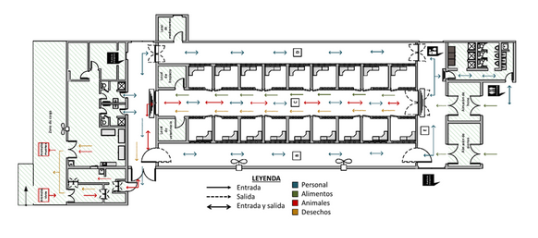Introduction of the first genetic nucleus of Murciano-Granadina goats in Cuba
Main Article Content
Abstract
Animal imports increase the risk of exposure of local or susceptible livestock to pathogens if the risk in imported animals is not properly managed. The combination of risk analysis, diagnosis and quarantine facilities is often the main strategy to mitigate such risk. The aim of this work was to ensure, from the sanitary point of view, the introduction of the first genetic nucleus of Murciano-Granadina goats in Cuba. To this end, sanitary requirements were harmonized between the Veterinary Authorities of exporter and recipient countries. Pre-shipment diagnostic tests were carried out and, once transported to Cuba, they were kept in a quarantine unit for 60 days during which time further research was carried out. Diagnostic testing at origin and destination showed no evidence of active infection. Viability of the imported goats was effectively preserved in the quarantine unit until their transfer to post-quarantine. There was an acceptable level of risk reached for the release of Murciano-Granadina goat nucleus for use in the Genetic Development Program of the species, which has been validated after animals have been in post-quarantine conditions for one year, showing good productive performance with no relevant health incidences.
Article Details

This work is licensed under a Creative Commons Attribution-NonCommercial 4.0 International License.
National Center for Animal and Plant Health (CENSA)References
Bidot A. y Muñoz R. Antecedentes históricos y el origen de las cabras. Ciencia y tecnología ganadera. 2016; 10 (1), 25-30.
Bidot A. Composición, cualidades y beneficios de la leche de cabra: revisión bibliográfica. Rev. prod. anim. 2017; 29(2) Camagüey may.-ago.
Cofré B. Producción de cabras lecheras. Chillán. Boletín INIA. 2001; 66, 132-134.
Vacas-Fernández C. Pasado, Presente y Futuro del Sector Caprino Murciano. Serie Técnica y de Estudios. 2015; No. 36. Imprenta Regional. 189p.
MINAG. Informe ovino-caprino. 2018.
MINAG. Actualización Programa Desarrollo EGAME. 2021.
Boukria O, El Hadrami EM, Sameen A, Sahar A, Khan S, et al. Biochemical, Physicochemical and Sensory Properties of Yoghurts Made from Mixing Milks of Different Mammalian Species. Foods. 2020;9:1722. Disponible en: http://dx.doi.org/10.3390/foods9111722
Miranda O, Espinos R, Ramírez J, Aldana J, y Sariol R. Leche de cabra. Composición físico-química, nutrimental y microbiológica. Revista cubana de alimentación y nutrición. 2023; 1(2), 4.
Webster W. Overview of the 2007 Australian outbreak of equine influenza. Australian veterinary journal. 2011; 89, 3-4.
Moloney B. Overview of the epidemiology of equine influenza in the Australian outbreak. Australian veterinary journal. 2011;89, 50-56.
Kuchipudi S, Behring D, Nissly R, Chothe S, et al. Mitigating the impact of emerging animal infectious disease threats: First Emerging Animal Infectious Diseases Conference (EAIDC) report. 2022.
Blake, A., Sinclair, M. T., y Sugiyarto, G. (2003). Quantifying the Impact of Foot and Mouth Disease on Tourism and the UK Economy. Tourism economics, 9(4), 449-465. https://doi.org/10.5367/000000003322663221
Thompson D, Muriel P, Russell D, Osborne P, et al. Economic costs of the foot and mouth disease outbreak in the United Kingdom in 2001. Rev sci tech off int epiz. 2002;21(3):675-87.
Gibbens J, Wilesmith J, Sharpe C, Mansley L, et al. Descriptive epidemiology of the 2001 foot‐and‐mouth disease epidemic in Great Britain: the first five months. Veterinary record. 2001;149(24), 729-743.
Binder, Monika. The Role of Risk and Cost-Benefit Analysis in Determining Quarantine Measures. Productivity Commission Working Paper. 2002;1699, Disponible en: SSRN: https://ssrn.com/abstract=304305
Brown R, Miller S, McKee S, Ernst K, et al. Risks of introduction and economic consequences associated with African swine fever, classical swine fever and foot‐and‐mouth disease: A review of the literature. Transboundary and emerging diseases, 2021;68(4), 1910-1965.
Yücer A. y Altıntaş O. Turkey’s animal selection and animal importation within the scopes of health and technical criteria. Bulg. J. Agric. Sci. 2021;27 (5), 972-979.
WOAH. Terrestrial Animal Health Code. OIE listed diseases and other diseases of importance to international trade. 2022;2. Disponible en: https://www.woah.org/en/what-we-do/standards/codes-and-manuals/terrestrial-code-online-access/
WOAH. Terrestrial Animal Health Code. Trade measures, import/export procedures and veterinary certification. 2022; Vol. 1. Section 5. Disponible en: https://www.woah.org/en/what-we-do/standards/codes-and-manuals/terrestrial-code-online-access/?id=169&L=1&htmfile=titre_1.5.htm
Consejo de Ministros. Decreto 38/2021 “Reglamento del Decreto-Ley 31 de Bienestar Animal” (GOC-2021-333-EX25). 2021. Disponible en https://www.gacetaoficial.gob.cu/sites/default/files/goc-2021-ex25-.pdf
Decreto-ley no. 31 de bienestar animal. Capítulo xi sobre la transportación animal. GOC-2021-332-EX25. 2021. ISSN 1682-7511. Disponible en: https://www.mined.gob.cu/wp-content/uploads/2022/01/goc-2021-ex25-.pdf.
Decreto 20 contravenciones de la medicina veterinaria. GOC-2021-134-O11. 2021. ISSN 1682-7511. Disponible en: https://www.gacetaoficial.gob.cu/sites/default/files/goc-2021-o11_0.pdf
Matsumoto N, MacPhillamy I, y Zalcma E. Indonesian import quarantine facility. 2022. Disponible en: https://s3.ap-southeast-2.amazonaws.com/wordpress.ausvet.com.au/wp-content/uploads/2022/11/Indonesian-import-quarantine-facility.pdf
Tawab A, El Hofy F, Moustafa E, Eldin T, et al. Isolation, Identification and Antimicrobial sensitivity of some fungi causing diarrhea in sheep and goats. 2021.
Esmaeili H, Bolourchi M, Mokhber-Dezfouli M, y Teimourpour A. Detection of Chlamydia abortus and risk factors for infection in small ruminants in Iran. Small ruminant research. 2021;97, 106339.
Körner S, Makert GR, Ulbert S, Pfeffer M y Mertens-Scholz K. The Prevalence of Coxiella burnetii in Hard Ticks in Europe and Their Role in Q Fever Transmission Revisited-A Systematic Review. Front. vet. sci. 2021,8:655715. doi: 10.3389/fvets.2021.655715
Lafi Q, Talafha A, Abu-Dalbouh M. et al. Seroprevalence and associated risk factors of Coxiella burnetii (Q fever) in goats and sheep in northern Jordan. Trop Anim Health Prod. 2020; 52, 1553-1559. Disponible en: https://doi.org/10.1007/s11250-019-02153-0
Jelocnik M, Huston W, y Newton H. Chlamydia and Coxiella. Chapter 20 en Pathogenesis of Bacterial Infections in Animals. Editores: John F. Prescott, Andrew N. Rycroft, John D. Boyce, Janet I. MacInnes, Filip Van Immerseel, José A. Vázquez-Boland, 2022; 433-455.
Migliore S, Puleio R, Nicholas R, y Loria G. Mycoplasma agalactiae: The sole cause of classical contagious agalactia? Animals. 2021;11(6), 1782.
Saikia G, Konch P, Boro A, Shome R, et al. Seroprevalence of caprine brucellosis in organised farms of Assam, India. J. entomol. zool. stud. 2019;7(1), 21-25.
Oyeleye F, Ezenduka E, y Okoli C. The operations of quarantine stations and the impact on animal disease prevention and control in Lagos State, south west, Nigeria. Animal research international, 2022;19(2), 4562-4570.
